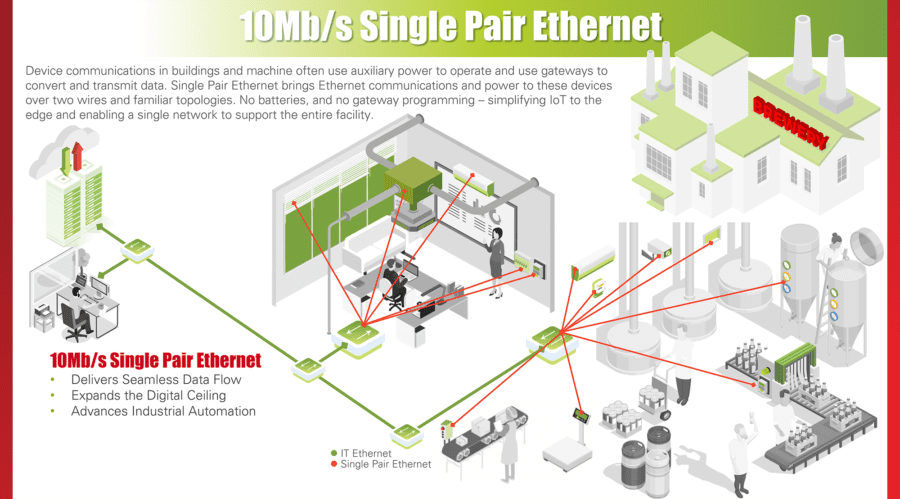For the past 40 years, Ethernet has evolved to dominate the data communications environment, first as one of many technologies for connecting computers to each other and to shared peripherals. Back in the days when computers were novel, information technology was a separate discipline.
Ethernet evolved along with computers to connect this space as it expanded to include many more “information technology” devices, such as telephones, wireless access points, and even special purpose boxes for streaming media. Today, nearly everything you can imagine contains a computer with Ethernet evolving to connect them all.
This has brought computer networking and Ethernet into places where the distance, noise, and other requirements are substantially different from the sterile halls of data centers, commercial buildings, and offices where it has flourished.
The trades and practices in these new environments – now referred to as “OT” or “Operational Technology” – are different from the “Information Technology” (IT) space. This world includes things like fire alarms, network access control, HVAC, lighting, small sensors, actuators, and even doorbells, which don’t fit the traditional IT models but have nearly invisible computers in them.
Think about it – who thinks of a doorbell as a computer? But today, a smart doorbell has networked microcontrollers, a camera, a network, and possibly even power over Ethernet (PoE). All of these are needed to do much more than simply make that “ding-dong” sound. The same goes for a myriad of other sensors and actuators in the OT world and operating infrastructures in buildings and factories.

10 Mb/s Single Pair Ethernet for OT Applications
In 2016, the 802.3™ Ethernet Working Group initiated the IEEE 802.3cg™ 10 Mb/S Single Pair Ethernet Task Force to bring Ethernet to the world of OT – driven by the needs of large plants in process automation.
For OT applications, reaches of 100 meters found in enterprise LANs were not nearly enough, impulse noise was commonplace, nodes were connected along multi-drop lines (rather than star wired), line powering was needed, and only a single pair of wires was often available.
The IEEE 802.3cg Task Force answered that call in 2019 by developing an IEEE standard for Ethernet at 10 Mb/s on a single balanced pair of conductors – generally a single twisted pair. “SPE” or “Single Pair Ethernet” thus brought Ethernet back from the lofty speeds of hundreds of Gb/s back to its roots at 10 Mb/s, addressing a different environment and application space. Since then, Ethernet has become a player in OT – the guts of a building or factory.
The point-to-point 10BASE-T1 physical layers (PHYs) of the IEEE 802.3cg standard project came in a short reach (15m) and a long reach (up to 1 km) form:
- 10BASE-T1S for networks up to 15 meters, primarily targeted at automotive applications;
- 10BASE-T1L for networks up to 1,000 meters, designed for IoT and industrial applications.
These technologies are now appearing as products and have been demonstrated by industrial companies for application in automated factories of the future.
The march towards a unified network architecture has begun. With it, the demand for more speed to feed the growing number of nodes, as well as other features to support the applications unveiled Ethernet’s promise to take the industrial world by storm.
Even during the pandemic shutdown, companies showed demonstrations of 10BASE-T1L equipment at industrial trade shows like ACHEMA Pulse 2021. Ethernet supplied 10 Mb/s of bandwidth to applications that had previously had 10’s of kb/s. Interest and imagination were sparked, and the number of projected nodes was growing.
IEEE P802.3dg Will Extend Ethernet Speed for the OT World
Recognizing the industry demand, the IEEE 802.3 Working Group began an activity to start considering the next phase of long-reach single pair Ethernet in 2021.
Applications went well beyond simply carrying the growing amount of data from linear networks with 10Mb/s spurs. They also considered emerging connectivity needs for sensors and actuators in renewable energy farms, mobile machines, and low-latency motion control loops for industrial servo motors, with the potential for addressing more than 45 million nodes per year in 2022.
Similar to how Ethernet evolved in the 1980s and 1990s, the project focused on the next-decade speed step – 100 Mb/s. While there is a 100BASE-T1 standardized under IEEE 802.3bw™-2015, it was targeted at automotive applications, with reaches of 15 meters.
The new IEEE P802.3dg™ standards project will target a much longer reach, suitable for OT applications, with an objective of up to 500m. This reach was targeted because of its commonality with one of the operating modes for the 10BASE-T1L PHY, making upgrades easy – along the path proven years ago by 4 pair wired Ethernet in the enterprise.
This helps address the demand for long reach, low latency, and low voltage signals in a noisy, impulsive environment. The IEEE P802.3dg standards project will look at higher performance modulation than 10BASE-T1L and possibly the use of forward error correcting codes and other techniques to deal with the challenges of the noise environment. The project will also serve low-latency links, possibly by enabling special operating modes with a shorter reach. Additionally, like IEEE 802.3cg, the new project has an aim to support associated power delivery along with the 100 Mb/s physical layer transmission.
Get Involved in IEEE P802.3dg
Supplying higher-speed, long-reach 100 Mb/s single pair Ethernet and power, IEEE P802.3dg is a leading-edge standards project to advance the performance and maintain the simplicity of Ethernet into new, harsher environments.
The IEEE P802.3dg Task Force welcomes any interested stakeholders to join this important effort; bringing a variety of expertise – not only physical layer design, but domain knowledge of OT applications, powering, and environmental constraints. Most of all, we welcome you to bring your imagination of where Ethernet could go next.
Get involved with the IEEE P802.3dg standards project or explore other IEEE 802 activities.
Author: George Zimmerman, IEEE P802.3dg Task Force Chair









